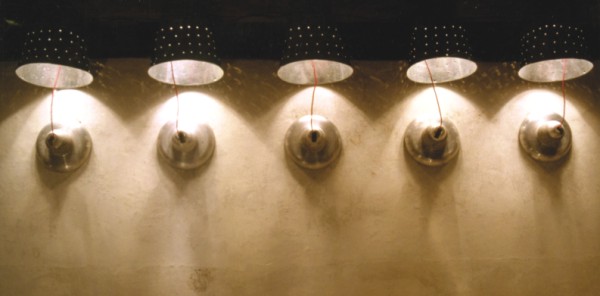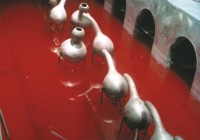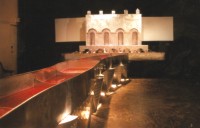|
Art

The
Apocalyptic
Invasion
of Water
Sajjad
Sharif
[Domenico:]
One drop plus one drop makes a bigger drop, not two.
-Nostalgia, Andrei Tarkovsky
Water
is the essence of life, realised Thales, the ancient sage
of Miletus. He witnessed how the flow of the Nile reached
every ion of the arid desert and made it so lush. Water helped
cover the desiccated desert with greenery. A barren desert
is synonymous with death. At the foot of Asia, we too hold
the same belief. We have always equated water with life. Could
what we Bangalis call life, mean something close to death
to our near cousins? At some point in history, did the water
coming from its very source contribute to the tragedy of a
populace? In the context of this three-decade-long predicament,
Dhali Al Mamoon has tried to interpret this phenomenon, somewhat
sceptically through his recent installation.
"Titled
Water is Innocent!"-- his installation art was shown
at the National Museum of Bangladesh. His installation centres
around the palace of the Chakma king that disappeared under
water. Water had come rushing in from the Kaptai Dam and inundated
all in its wake. The discerning spectators of Mamoon's art
will surely remember that traces of the lost palace of the
Chakma king have been recurrent in his art of last couple
of years. At the end of the gallery space, in a rectangular
water reservoir, Mamoon has installed a metal replica of the
palace. From this central piece to the other end of the gallery,
Mamoon lets the water flow in a single stream. This is where
his idea takes off. Mamoon gives shape to his concept by incorporating
many other elements. The writings of the hill people on the
subject of water, the threads for textile used by them, photographs
as well as their painterly interpretations, video footages
of the on-rushing water from kaptai Dam, a panel full of eyes
-- some with and some without pupils, all these elements unite
in a harmonious whole and contribute to the displacement of
the palace replica as the central piece. The Tibetan chant
used as background music, adds to the ambience. The palace
becomes a backdrop of sorts in the presence of all these elements.
It is from this context that the obscure relations of all
the elements become apparent. And after realising these relationships
the historical, religious, anthropological and political implications
of Mamoon's thoughts on the hill people, reach a common focal
point.
 Still,
the presence of water subjugates all other elements. The flowing
water gives life to the installation that is manifested among
its solid and inanimate structures. Water becomes the central
force, as well as the driving spirit of the work. The cascading
water that adorns the palace walls. The sinuous waterway that
flows from the water reservoir. Water that spills over from
the dangling dried-gourd pots displayed in a row in front
of the palace. Water that drips from the eyes of the panel.
Water that seeps out of the crucifix in the picture depicting
baptism of the hill people. Water that clings to the ground
in the video footage of the Captai Lake. Deep red water, and
the organic reflection of that on the wall. Still,
the presence of water subjugates all other elements. The flowing
water gives life to the installation that is manifested among
its solid and inanimate structures. Water becomes the central
force, as well as the driving spirit of the work. The cascading
water that adorns the palace walls. The sinuous waterway that
flows from the water reservoir. Water that spills over from
the dangling dried-gourd pots displayed in a row in front
of the palace. Water that drips from the eyes of the panel.
Water that seeps out of the crucifix in the picture depicting
baptism of the hill people. Water that clings to the ground
in the video footage of the Captai Lake. Deep red water, and
the organic reflection of that on the wall.
Why did
Mamoon present water in red? Was it to symbolise blood? Was
it to put an end to the idea of water as clear, sanctified
and immaculate in nature?
It is
difficult to believe that Mamoon is oblivious of the ferocity
of water when it charges against the people living in proximity
with nature. He knows very well that nature is non-sentient.
Behind its brutality, there is no ill will or determination
to do harm. Nature becomes ferocious only when the ill intention
of man provokes it. The text that accompanies this installation
shows that Mamoon is aware of all this. Let's have a look
at the Bangla translation of a couple of writings. Shilabrata
Tangchangya wrote:
I still
hear the booming sounds of the dam gate closing that continued
throughout the whole night. By morning, water had reached
our doorsteps. We set free our cows and goats, hens and ducks,
and then began to rush along with other affected people to
take their rice, paddy, furniture and whatever else possible
to the nearby hills...Though every belonging was taken to
the hill top, many people still remained in their houses to
spend the night. But many of them had to rush out of their
houses at the dead of night when the swelling water touched
them while they slept.
T. Roy
wrote: It was called a multi-purpose dam, for it was supposed
to provide not only electricity, but to control flood in the
areas of Chittagong and irrigation facilities. As it turned
out, every year since the dam was built, there have been floods
in the very region it was supposed to save, with unfailing
regularity. As for irrigation, by its very coming into existence
it submerged most of the cultivable lands and there was hardly
anything left to irrigate...there were two benefits besides
the generation of electricity, which is improvement in navigation,
(though rates of siltation have been more rapid in the upper
reaches of the [reservoir] than expected) and fishery. Needless
to say, despite often-repeated and grandiose government plans
and promises, not a single tribal village has been electrified
-- though electricity found its way into towns, as well as
villages in the districts of the flat plains.
While
standing vis-à-vis Mamoon's installation, it seems
that the artist had a clear notion of the idea of colonisation.
In fact the way he presented water points to the concept of
colonisation. To be more specific, one may call it displacement,
which resulted from the inundation of a vast region.
The great
exodus was triggered by the hill people from their homes in
the face of Bangali majoritarian domination, and the onrush
of the unleashed water from Kaptai Dam. Through the presentation
of the swinging dried-gourd pots, this pain of the loss of
habitat is evoked. Blood pours out from the headless necks
of these pots that resemble the bodies of swans. The image
creates an intense atmosphere.
 While
creating this artwork, Dhali Al Mamoon's artwork is invariably
inspired by political matters. In this particular artwork,
however, the intensity of the political question has simply
hurled him onto the very platform of the emotional crisis
of the hill people, and helped widen the implications of the
idea of displacement. In one of the writings, Mamoon presents
the worldview of the hill people in connection to a sixteenth
century text titled Goyel Lama written by Shibcharan Chakma: While
creating this artwork, Dhali Al Mamoon's artwork is invariably
inspired by political matters. In this particular artwork,
however, the intensity of the political question has simply
hurled him onto the very platform of the emotional crisis
of the hill people, and helped widen the implications of the
idea of displacement. In one of the writings, Mamoon presents
the worldview of the hill people in connection to a sixteenth
century text titled Goyel Lama written by Shibcharan Chakma:
"The
river was coming down from its source, all are flowing waterways/There
was no other creation, only the sound emanating from water/Then
emerged land from that water/God made man after Him."
It is
in this context that the artist has projected a photograph
-- an extraneous element in his painting, where one of the
hill people is being bathed by the immaculate water of baptism.
In bringing this into focus, he sheds light on the pull of
the two conflicting aspects and by doing so, he lends displacement
a degree of salience. The silent departure of a race from
its own creed and religion and the gradual replacement of
that universal creed by induction into another alien creed,
namely Christianity, the step to consider a local idea that
was their own into the 'other', all these are addressed. In
this context, one understands that Mamoon does not see the
agony of being displaced in one particular dimension, nor
does he think it is a consequence of any particular phenomenon.
An ambiguous
resonance is left in the corner of one's mind even after leaving
the installation behind. As a result, one realises that Mamoon
has alluded to things beyond the aggression of water. Then
one wakes up to the faint reverberation of empathy of the
tear-like drippings of water.
Translated
by Mustafa Zaman
Copyright
(R) thedailystar.net 2004
| 